Top names like Apple, Google, X, Airbnb, and Uber are quietly exploring the potential of stablecoins—price-stable digital currencies—to reshape the global payment system. This shift promises not only speed, low costs, and the stability of the USD but also marks a significant turning point in how businesses operate.
Stablecoins Dominating B2B Payments
Stablecoins are making a strong impact in the business-to-business (B2B) payment sector, thanks to their fast transaction speeds, low costs, and ability to maintain stable value. Statistics show that B2B transactions using stablecoins have reached $36 billion out of a total of $94 billion, far surpassing peer-to-peer payment methods and card payments. This development is further bolstered by support from the U.S. government, particularly during Trump’s presidency, facilitating businesses to integrate this technology.
On-Chain Payments: A New Trend for Tech Giants
Many leading tech corporations are in preliminary discussions with cryptocurrency companies to implement stablecoins—digital tokens pegged to the USD—into their payment systems. The goal is to reduce card transaction fees, simplify international payments, and protect corporate treasury in the long term. Major partners like Stripe and Worldpay are also being invited to assist with stablecoin payment processing.
- Airbnb is experimenting with integrating stablecoins through a partnership with Worldpay.
- X (formerly Twitter) is considering incorporating stablecoins into the X Money app to expand financial services.
- Google Cloud has pioneered accepting payments in stablecoins (specifically PayPal’s PYUSD) for select customers, without changing traditional payment systems.
Why Are Stablecoins Rising?
While not a new concept, stablecoins are entering a maturation phase due to policy changes and advancements in technology infrastructure. Stripe’s acquisition of stablecoin startup Bridge is a clear testament to the potential of this sector. Chris Ahn from Haun Ventures states, “Stablecoins are an old idea, but now the pieces are starting to fit together, creating a complete picture.”
Stablecoins offer flexibility in treasury management, enabling companies to make cross-border payments quickly, transparently, and optimize liquidity strategies. Instead of holding fiat currency, businesses can use stablecoins to leverage the advantages of blockchain technology.
Meta and Uber Join the Race
Not to be left out, Meta is researching the application of stablecoins to reduce international transaction costs, particularly for content creators on Instagram. Meanwhile, Uber CEO Dara Khosrowshahi has confirmed that the company is considering integrating stablecoins as a potential payment method in the future.
Despite the significant potential, businesses remain cautious. The unclear audit history of Tether and changes in the ownership of USDC raise questions among executives about transparency and compliance. Selecting a reliable stablecoin issuer for large-scale operations remains a major barrier, slowing widespread adoption.
Related: Truth Social Registers Bitcoin and Ethereum ETF in Nevada
A Threat to Visa and Mastercard
Stablecoins have the potential to disrupt the position of giants like Visa and Mastercard, especially in cross-border and high-value transactions. By eliminating the need to use card networks, stablecoins could cause traditional processors to lose billions in transaction fees each year.
The stablecoin market currently has a record capitalization of $250 billion and is forecasted to reach $2 trillion by 2028, according to Standard Chartered. This growth could be significantly accelerated if the GENIUS Act—a draft law aimed at establishing a clear regulatory framework for stablecoins in the U.S.—is passed.








